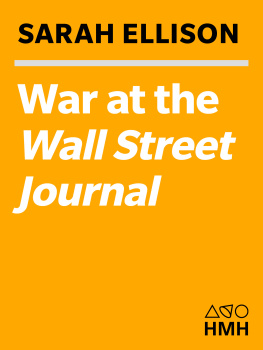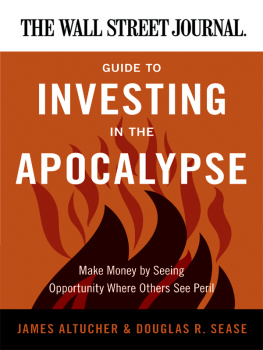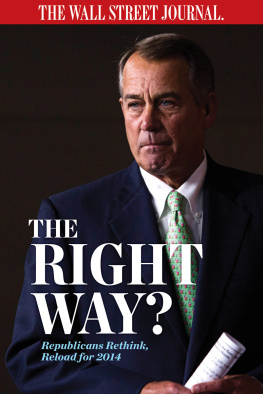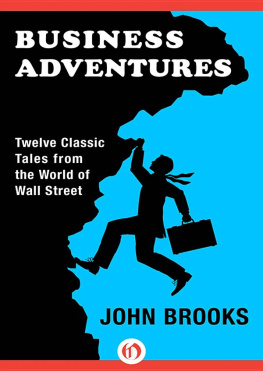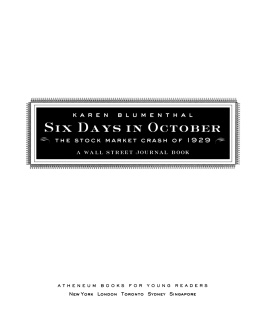Copyright 2010 by Sarah Ellison
ALL RIGHTS RESERVED
For information about permission to reproduce selections from this book, write to or to Permissions, Houghton Mifflin Harcourt Publishing Company, 3 Park Avenue, 19th Floor, New York, New York 10016.
www.hmhco.com
The Library of Congress has cataloged the print edition as follows:
Ellison, Sarah.
War at the Wall Street journal : inside the struggle to control an American
business empire / Sarah Ellison.
p. cm.
ISBN 978-0-547-15243-1
1. Wall Street journal. 2. Dow Jones & Co. I. Title.
PN 4899. N 42 W 28 2010
071'.3dc22 2009046266
e ISBN
v2.0316
Excerpts from Family Dynamics: Behind the Bancrofts Shift at Dow JonesMounting Pressure from Dissident Wing Raises Odds of a Sale, by Matthew Karnitschnig, Sarah Ellison, Susan Pulliam, and Susan Warren (June 2, 2007), and from Richard F. Zanninos letter to the Dow Jones board are reprinted by permission of Dow Jones & Company.
For Jesse
Cast of Characters
THE BANCROFTS
Clarence Barron, Bancroft patriarch, early Dow Jones owner
Hugh Bancroft, Clarence Barrons son-in-law, early Dow Jones president
Jessie Cox, Clarence Barrons granddaughter
Jane Cook, Clarence Barrons granddaughter
Hugh Bancroft Jr., Clarence Barrons grandson
Jane MacElree, Jessie Coxs daughter
Bill Cox Jr., Jessie Coxs son
Jean Stevenson, Jane Cooks daughter
Martha Robes, Jane Cooks daughter
Lisa Steele, Jane Cooks daughter
Christopher Bancroft, Hugh Bancroft Jr.s son
Hugh Bancroft III, Hugh Bancroft Jr.s son
Bettina Bancroft, Hugh Bancroft Jr.s daughter
Elisabeth Lizzie Goth Chelberg, Bettina Bancrofts daughter
Leslie Hill, Jane MacElrees daughter
Michael Hill, Jane MacElrees son
Tom Hill, Jane MacElrees son
Crawford Hill, Jane MacElrees son
William Cox III, Bill Cox Jr.s son
ADVISERS
Michael Puzo, Hemenway & Barnes attorney, Bancroft trustee
Jim Lowell, financial adviser to Hemenway & Barnes on Bancroft accounts
Roy Hammer, Hemenway & Barnes attorney, Bancroft trustee, Dow Jones board member
Michael Elefante, Hemenway & Barnes attorney, Bancroft trustee, Dow Jones board member
Martin Lipton, partner at Wachtell, Lipton, Rosen & Katz, adviser to Bancroft family
THE MURDOCHS
Rupert Murdoch, News Corp. chairman/CEO
Wendi Deng Murdoch, Rupert Murdochs wife
Prudence MacLeod, Ruperts eldest daughter
Elisabeth Murdoch, Ruperts daughter
Lachlan Murdoch, Ruperts elder son
James Murdoch, Ruperts younger son
Grace Murdoch, Ruperts daughter
Chloe Murdoch, Ruperts youngest daughter
ADVISERS
Andrew Steginsky, independent money manager, adviser to Rupert Murdoch
DOW JONES & COMPANY
Peter Kann, former Dow Jones CEO, president, and Journal publisher
Karen Elliott House, former Journal publisher
Paul Steiger, former Journal managing editor
Richard Zannino, former Dow Jones CEO
Marcus Brauchli, Journal managing editor
Gordon Crovitz, Journal publisher
Irvine Hockaday, Dow Jones board member
Frank Newman, Dow Jones board member
Peter McPherson, Dow Jones board member
Harvey Golub, Dow Jones board member
Lewis Campbell, Dow Jones board member
William Steere, Dow Jones board member
Bill Grueskin, Journal deputy managing editor for news coverage
Paul Gigot, editorial page editor of the Journal
Nikhil Deogun, Journal editor
Martin Peers, Journal editor
Paul Ingrassia, president of Dow Jones Newswires
Joseph Stern, Dow Jones general counsel
James Ottaway, Dow Jones board member
Richard Beattie, chairman of Simpson Thacher & Bartlett, adviser to Dow Joness independent directors
NEWS CORP.
Gary Ginsberg, News Corp. EVP of global marketing and corporate affairs
Lon Jacobs, News Corp. general counsel
David DeVoe, News Corp. CFO
Roger Ailes, chairman/CEO of Fox News Channel and Fox BusinessNetwork
Leslie Hinton, former executive chairman of News International
Robert Thomson, former Times of London editor
James Bainbridge Lee Jr., JPMorgan Chase banker, adviser to News Corp.
Blair Effron, Centerview Partners, adviser to News Corp.
Prologue
G AIL GREGG WALKED confidently up the gangway to join the small gathering on Barry Dillers yacht on a warm August night in 2007. Yet when she saw Rupert Murdoch, nemesis of her husband, New York Times publisher Arthur Sulzberger Jr., she forgot the promise of the evening and almost threw herself into the Hudson River.
The tabloids would note the party briefly, but this event wasnt designed for mentions in columns with boldface names. No press passes had gone out to humble journalists. The powerful would mingle privately, exchanging pleasantries and tidbits, setting up potentially useful future exchanges. Relationships would evolve quietly under the setting sun. Yet beneath the clinking of cocktail glasses something else was taking place, namely, the latest phase of a competition involving the future of two of Americas most important publications and a battle for supremacy over who would control what the nation read, thought, and believed.
The guests aboard Dillers beautiful 118-foot cruiser knew that reality was the creation of the highest bidder. Their media empires didnt merely report the news; they chose and shaped it. Yet tonights stated purpose was not strictly business: at the top of the agenda was the viewing of Dillers new IAC/InterActiveCorp headquarters from the water, with a tour to follow. Diller, a comfortable host and a bit of a showman, had arranged things a week or so earlier. The evening light would perfectly showcase the rather controversial building, designed by architect Frank Gehry to evoke eight wind-whipped sails ready to glide out onto the river. But the strange and graceful edifice was no ones notion of the big news story on that particular evening.
In the wee hours of that morning, Rupert Murdoch had secured a $5 billion deal to buy Dow Jones & Company and the Wall Street Journal from the Bancrofts, one of the countrys last remaining newspaper families, who had owned the company for 105 years through thirty-three Pulitzers. The only other time Dow Jones had been purchased was for $130,000 in 1902 by Clarence Barron, whom some called the originator of financial writing but whom the Bancrofts referred to as Grandpa. The founder of the Boston News Bureau, he had purchased the company with a $2,500 down payment loan from his wife, Jessie Waldron, whose cooking the five-foot-five, 330-pound patriarch had enjoyed as a longtime guest at Ms. Waldrons boarding house.
The purchase had ensured that the later generations of the Bancroft family were bonded together, however reluctantly or tentatively. Without it, the Boston-based clan would feel like just another rich family, a status the elders in the clan were reluctant to embrace. As the generations progressed, their relationships grew ever more tenuous. Murdochs money would allow them to be rid of one another. It would allow him something else entirely: the $5 billion purchase of the daily diary of the American dream was the likely culmination of his controversial career, which had helped shape the century. The paper would become the flagship of his News Corporation.
The seventy-six-year-old Murdoch, his auburn-dyed hair receded halfway back his head, his brow permanently creased as his smile emerged from the crevasses that lined his face, looked relaxed and vibrant in the stifling summer heat. He accepted congratulations in his softly accented Australian mumble. For almost two decades he had coveted just these plaudits. But the question of whether the purchase was actually a triumph would be avidly debated in the Hamptons and elsewhere as the summer came to its close. Some called his timing all but laughable, given the print mediums sorry state. Most noted that the man who had always indulged his penchant for what he called populist papers had now steered himself into an impossible challengeengineering the subtle metamorphosis of a beloved, sophisticated publication with a dwindling audience in the midst of the scariest media moment in recent memory.
Next page
